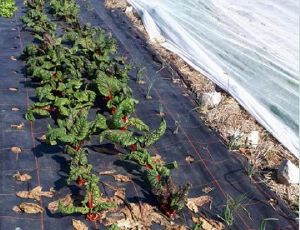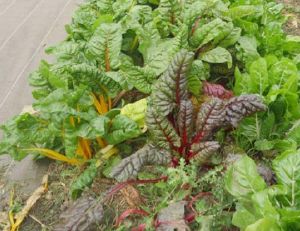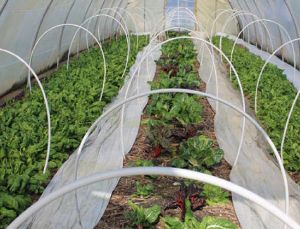Chard

Hardy and easy to look after, chard is a simple easy to plant. However, it it is not necessarily appreciated by all consumers. Playing with shapes and to make it more attractive.
Preparing the soil
At the start of the season, a tarpaulin cover before the crop is planted can limitweed growth. The crop's needs of the crop should be assessed in the light of the production: for example, chard grown under cover for several under cover for several cuts is more demanding than outdoor with a single cut. A 10-15 cm layer of ripe compost provides a clean seedbed, especially for direct sowing. direct sowing. As part of the planting routine, a tarpaulin can be laid to transplant the clods.
Planting

In the planting itinerary, one glomerule per clod will have been sown beforehand so that, after emergence, only one or two seedlings remain (one if you are looking for a large rib). The clods are then transplanted into a tarpaulin with a hole in it. This has the advantage of improving the start of the crop This has the advantage of improving the crop's start-up, especially in spring, and keeping down weeds.
Manual planting is recommended, with a spacing of 3 to 5 plants/m² for chard and 14plants/m² for mini plants/m² for mini pear crops.
Tip
Chard seed is a glomerule, a cluster of several seeds. So, when seedlings, use onlyoneglomerule per plant. glomerule per plant.

Variety
- White chard : easily identifiable standard product
- With coloured chard : eye-catching product
Cultivation monitoring
In the case of the tarpaulin route, weeding is more limited and is confined to the holes in the canopy. and is confined to the planting holes. In the case of direct seeding, it may be necessary to thin out the seedbed thin out the seed if it is too thick. At the beginning to limit competition from weeds, and then leave it to grow. then let the weeds grow if they do.

To obtain a harvest in winter, it is necessary to mulchthe crop to protect it from the cold. the crop to protect it from the cold.
Irrigation
Water requirements are high and will be met in theopen field by rain and frequent drip or sprinkler irrigation . or sprinklers. Under cover, watering will be under cover.
Harvest
Chard has a fairly rapid cycle, with the first harvests coming arrive 75 days after sowing and then for several months. It is harvested by hand in 2 different ways :
- Single-cut harvesting for 500 g to 1 kg per plant, this is a mini-pear harvest; it is done by cutting under the collar with a knife. There will be no regrowth.
- Harvested in several cuts spaced about 15 days apart, this is a chard harvest; the leaves are removed from the outermost ribs by breaking them at the base with a sharp blow.
Storage
Chard does not keep well for long, and should be harvested harvested shortly before marketing. During this time, they should be stored in a cool, dry place. Store at between 0 and 1°C for 8 to 10 days.
Pests and diseases
- Chard is susceptible to various fungal diseases such as mildew andpowdery mildew. Avoid over-watering and ensure the crop is well aerated.
- Insect-proof netting can be useful for aerial pests such as noctuid moths, flea beetles and aphids.
Adapting to the soil and climate

Chard can be grown almost all year round.
Summer harvests are more susceptible to drought while winter frosts can destroy the crop. the crop. However, chard can also be grown under cover (Nantes tunnel, caterpillar, etc.) or in the open field to adapt to the season.
Possible ITK variations
For direct sowing, it is better to have a fairly fine seedbed with :
- A spread of compost (5 cm minimum), which serves to black out the soil to prevent weeds from emerging and to create an aerated seedbed. If you're using a seed drill, remove any pieces of wood from the compost so that the drill doesn't "jam".
- Rolling the seed to press it into the soil can encourage germination.
Photo gallery
Sources
- This page is based on the guide Introduction au maraîchage sol vivant by MSV Normandie.
